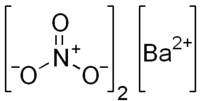Barium nitrate
 |
|
 |
|
| Names | |
|---|---|
| Other names
Barium dinitrate,
, barium salt |
|
| Identifiers | |
|
10022-31-8 |
|
| 3D model (Jmol) | Interactive image |
| ChemSpider |
23184 |
| ECHA InfoCard | 100.030.006 |
| PubChem | 24798 |
| RTECS number | CQ9625000 |
| UNII |
MDC5SW56XC |
|
|
|
|
| Properties | |
| Ba(NO3)2 | |
| Molar mass | 261.337 g/mol |
| Appearance | white, lustrous crystals |
| Odor | odorless |
| Density | 3.24 g/cm3 |
| Melting point | 592 °C (1,098 °F; 865 K) (decomposes) |
| 4.95 g/100 mL (0 °C) 10.5 g/100 mL (25 °C) 34.4 g/100 mL (100 °C) |
|
| Solubility | insoluble in alcohol |
| -66.5·10−6 cm3/mol | |
|
Refractive index (nD)
|
1.5659 |
| Structure | |
| cubic | |
| Hazards | |
| Safety data sheet | See: data page |
|
EU classification (DSD)
|
Harmful (Xn) |
| R-phrases | R20/22 |
| S-phrases | (S2), S28 |
| NFPA 704 | |
| Flash point | noncombustible |
| Lethal dose or concentration (LD, LC): | |
|
LD50 (median dose)
|
355 mg/kg (oral, rat) 187 mg/kg (rat, oral) |
|
LDLo (lowest published)
|
79 mg Ba/kg (rabbit, oral) 421 mg Ba/kg (dog, oral) |
| US health exposure limits (NIOSH): | |
|
PEL (Permissible)
|
TWA 0.5 mg/m3 |
|
REL (Recommended)
|
TWA 0.5 mg/m3 |
|
IDLH (Immediate danger)
|
50 mg/m3 |
| Supplementary data page | |
|
Refractive index (n), Dielectric constant (εr), etc. |
|
|
Thermodynamic
data |
Phase behaviour solid–liquid–gas |
| UV, IR, NMR, MS | |
|
Except where otherwise noted, data are given for materials in their standard state (at 25 °C [77 °F], 100 kPa).
|
|
|
|
|
| Infobox references | |
Barium nitrate with chemical formula Ba(NO3)2 is a salt composed of barium and the nitrate ion.
Barium nitrate exists as a white solid at room temperature. It is soluble in water, and like other soluble barium compounds, is toxic. It occurs naturally as the very rare mineral nitrobarite. Barium nitrate's properties make it suitable for use in various military applications, including thermite grenades and incendiary ammunition.
Barium nitrate is manufactured by one of two processes. The first involves dissolving small chunks of barium carbonate in nitric acid, allowing any iron impurities to precipitate, then filtered, evaporated, and crystallized. The second requires combining barium chloride with a heated solution of sodium nitrate, causing barium nitrate crystals to separate from the mixture.
At elevated temperatures, barium nitrate decomposes to barium oxide, nitrogen dioxide, and oxygen:
In an atmosphere of nitric oxide, thermal decomposition produces barium nitrite (Ba(NO2)2). Reactions with soluble metal sulfates or sulfuric acid yield barium sulfate. Many insoluble barium salts, such as the carbonate, oxalate and phosphate of the metal, are precipitated by similar double decomposition reactions. Barium nitrate is an oxidizer and reacts vigorously with common reducing agents. The solid powder, when mixed with many other metals such as aluminium or zinc in their finely divided form, or combined with alloys such as aluminium-magnesium, ignites and explodes on impact.
Baratol is an explosive composed of barium nitrate, TNT and binder; the high density of barium nitrate results in baratol being quite dense as well. Barium nitrate mixed with aluminium powder, a formula for flash powder, is highly explosive. It is mixed with thermite to form Thermate-TH3, used in military thermite grenades. Barium nitrate was also a primary ingredient in the "SR 365" incendiary charge used by the British in the De Wilde incendiary ammunition with which they armed their interceptor fighters, such as the Hawker Hurricane and Supermarine Spitfire, during the Battle of Britain. It is also used in the manufacturing process of barium oxide, the vacuum tube industry and for green fire in pyrotechnics.
...
Wikipedia

